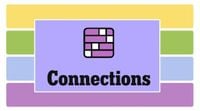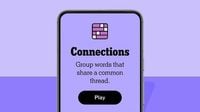On August 8, 2025, puzzle enthusiasts across the globe woke up to the latest challenge from The New York Times Games section: Connections puzzle #790. This daily word game, rapidly rising in popularity alongside stalwarts like Wordle and the Mini Crossword, once again invited players to spot the hidden links between seemingly unrelated words. As the sun rose and the game reset at midnight, thousands dove in, eager to test their wits against the day’s clever categories and tricky groupings.
Connections, introduced by associate puzzle editor Wyna Liu and her team, has quickly become a fixture of morning routines and social media feeds. According to Mashable, the game’s premise is simple but addictive: players must sort 16 words into four groups of four, each group sharing a subtle common thread. But as any regular will tell you, the simplicity is deceptive—some days, the connections are obvious, while other days they require a leap of logic or a keen eye for wordplay. And with only four mistakes allowed before the game ends, the stakes feel surprisingly high for a few minutes of word wrangling.
For puzzle #790, the Connections team delivered a set that, as Mashable described, got “trickier and trickier” as the clock ticked past midnight. The day’s categories were revealed in stages, with hints and nudges offered to those stuck in the early morning fog. The yellow group was themed “Make equal, as a score,” the green group “Bestow,” the blue group “Things you might do during a boring class or meeting,” and the purple group “Words after the letters ‘MS’.” Each group had its own flavor—ranging from the straightforward to the downright quirky.
Players who dove into the yellow category quickly found themselves thinking of sports, games, and competitions. The solution—DRAW, EVEN, SQUARE, TIE—was a satisfying click for anyone familiar with the language of scoring. As CNET pointed out, “No one is ahead or behind” was the guiding clue, and the words themselves evoked stalemates and balanced outcomes. It was a classic Connections grouping: simple, clear, and pleasingly logical once you saw it.
The green group, themed “Bestow,” was a little trickier. The answers—CONFER, GRANT, PRESENT, VEST—required players to think about synonyms for giving or awarding something. Here, the editors played with the subtle differences between bestowing honors, granting permissions, and presenting awards. Mashable noted that “multiple words will seem like they fit together, but there’s only one correct answer,” and nowhere was that more true than in this cluster. The difference between ‘grant’ and ‘present’ is slight, but only these four made the cut.
Blue, always a crowd-pleaser, took players back to school (or perhaps a dull office meeting). The category, “Things you might do during a boring class/meeting,” included DOODLE, DOZE, PASS NOTES, and SPACE. As CNET quipped, the hint was “Zzzz...Bueller? Bueller?”—a nod to the classic Ferris Bueller’s Day Off and the universal experience of zoning out. It’s a group that brings a smile of recognition to anyone who’s ever idly scribbled in the margins or let their mind wander when the minutes drag on.
And then there was purple—the most difficult group, as always. This time, the editors got creative: “Words after the letters ‘MS’.” The answers—DEGREE, MARVEL, PAC-MAN, PAINT—required players to imagine how each word could follow ‘MS’ to form a familiar phrase or name (MS DEGREE, MS MARVEL, MS PAC-MAN, MS PAINT). As Mashable explained, “Even though multiple words will seem like they fit together, there’s only one correct answer.” The purple group is notorious for its curveballs, and today’s was no exception. Some players, lured by the presence of PAC-MAN, spent ages searching for other video games, only to realize the connection was hiding in plain sight.
Of course, not everyone cracked the code on their own. Both Mashable and CNET offered hints and strategies for those desperate for a nudge. “Say the clue words out loud, pausing before and after each,” advised CNET—a tip that’s helped many a stumped solver. Other suggestions included shuffling the grid to spot new patterns and breaking down compound words to see if hidden relationships emerged. And if all else failed, the answers were just a scroll away, though many preferred to resist the temptation and keep their streaks alive.
For those who thrive on competition, The New York Times has added features to track progress and compare results. Registered users can now follow their win rates, streaks, and perfect scores, and even see how their performance stacks up against the editor’s rating. According to the NYT Connections Companion, puzzle #790 was rated 2.8 out of 5 in difficulty by testers—challenging but not insurmountable. And for the truly dedicated, the new Connections Bot offers personalized analysis and feedback, turning every daily puzzle into a chance to learn and improve.
Community is a big part of Connections’ appeal. The daily forum, as described by The New York Times, is a space for players to share their solve grids, swap stories, and offer encouragement (or commiseration) to fellow connectors. The comments are moderated for civility, and the mood is more supportive than competitive. “Be kind,” the editors remind readers—a simple rule that keeps the community welcoming and fun.
With each new puzzle, Connections cements its place as a staple of digital wordplay. It’s not just about finding the right answers, but about the little rush of recognition, the shared experience of a clever twist, and the satisfaction of starting the day with a small victory. And for those who didn’t quite manage to guess it this time, there’s always tomorrow—a new set of words, a fresh challenge, and another chance to connect the dots.
As the clock resets and puzzle #791 looms on the horizon, fans can rest assured: the Connections team will be back with more categories, more curveballs, and more reasons to keep coming back. Until then, happy connecting.






